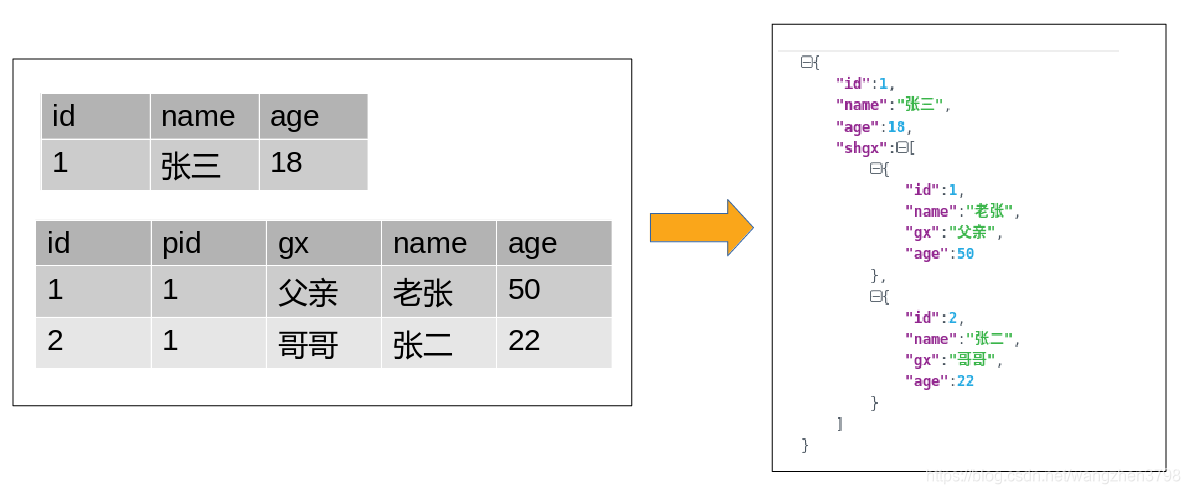Elasticsearch中如何进行排序(中文+父子文档+嵌套文档) |
您所在的位置:网站首页 › es查询结果不对 › Elasticsearch中如何进行排序(中文+父子文档+嵌套文档) |
Elasticsearch中如何进行排序(中文+父子文档+嵌套文档)
|
Elasticsearch中如何进行排序
背景
最近去兄弟部门的新自定义查询项目组搬砖,项目使用Elasticsearch进行数据的检索和查询。每一个查询页面都需要根据选择的字段进行排序,以为是一个比较简单的需求,其实实现起来还是比较复杂的。这里进行一个总结,加深一下记忆。 前置知识Elasticsearch是什么? Elasticsearch 简称ES,是一个全文搜索引擎,可以实现类似百度搜索的功能。但她不仅仅能进行全文检索,还可以实现PB级数据的近实时分析和精确查找,还可以作GIS数据库,进行AI机器学习,功能非常强大。 ES的数据模型 ES中常用嵌套文档和父子文档两种方法进行数据建模,多层父子文档还可以形成祖孙文档。但是父子文档是一种不推荐的建模方式,这种方式有很多的局限性。如果传统关系型数据库的建模方法是通过“三范式”进行规范化,那么ES的建模方法就是反范式,进行反规范化。关系型数据库的数据是表格模型,ES是JSON树状模型。
根据建模方法的不同,ES中排序分为以下几种,每种都有不同的排序写法和一些限制: 嵌套文档-根据主文档字段排序 嵌套文档-根据内嵌文档字段排序 父子文档-查父文档然后根据子文档排序 父子文档-查子文档然后根据父文档排序 更复杂的情况,父子文档里又嵌套了文档,然后根据嵌套文档字段进行排序。下面分别对其中某几种情况和中文字段的排序,进行测试说明(ES 5.5.x)。 测试数据准备首先,设置索引类型字段映射 PUT /test_sort { "mappings": { "zf":{ "properties": { "id":{"type": "keyword"}, "name":{"type": "keyword"}, "age":{"type": "integer"}, "shgx":{"type": "nested"} } } } }然后新建测试数据 PUT /test_sort/zf/1 { "id":1, "name":"张三", "age":18, "shgx":[{ "id":1, "name":"老张", "age":50, "gx":"父亲" },{ "id":2, "name":"张二", "age":22, "gx":"哥哥" }] } PUT /test_sort/zf/2 { "id":2, "name":"李四", "age":25, "shgx":[{ "id":3, "name":"李五", "age":23, "gx":"弟弟" }] } 嵌套文档-根据主文档字段排序 根据zf主文档age字段倒叙排列,直接加sort子语句就可以 POST /test_sort/zf/_search { "query": { "match_all": { } }, "sort": [ { "age": { "order": "desc" } } ], "_source": {"include": ["id","name","age"]} }结果: "hits": [ { "_index": "test_sort", "_type": "zf", "_id": "2", "_score": null, "_source": { "name": "李四", "id": 2, "age": 25 }, "sort": [ 25 ] }, { "_index": "test_sort", "_type": "zf", "_id": "1", "_score": null, "_source": { "name": "张三", "id": 1, "age": 18 }, "sort": [ 18 ] } ] 嵌套文档-根据内嵌文档字段排序 根据age小于50岁的亲属排序,理论上李四应该排第一位,因为50岁以下的亲属,李五最大。 凭直觉先这样写: POST /test_sort/zf/_search { "query": { "nested": { "path": "shgx", "query": { "range": { "shgx.age": { "lt": 50 } } } } }, "sort": [ { "shgx.age": { "nested_path": "shgx", "order": "desc" } } ] }看结果: "hits": [ { "_index": "test_sort", "_type": "zf", "_id": "1", "_score": null, "_source": { "id": 1, "name": "张三", "age": 18, "shgx": [ { "id": 1, "name": "老张", "age": 50, "gx": "父亲" }, { "id": 2, "name": "张二", "age": 22, "gx": "哥哥" } ] }, "sort": [ 50 ] }, { "_index": "test_sort", "_type": "zf", "_id": "2", "_score": null, "_source": { "id": 2, "name": "李四", "age": 25, "shgx": [ { "id": 3, "name": "李五", "age": 23, "gx": "弟弟" } ] }, "sort": [ 23 ] } ]非常重要!结果是错误的。这是因为嵌套文档是作为主文档的一部分返回的,在主查询中的嵌套文档的过滤条件并不能把不符合条件的内部嵌套文档过滤掉,返回的还是整个文档(主文档+完整的嵌套文档)。以至于按嵌套文档字段排序时,还是按照全部的嵌套文档进行排序的。要正确的实现排序,就要把主查询中有关嵌套文档的查询条件,在排序中再写一遍。 正确的写法: POST /test_sort/zf/_search { "query": { "nested": { "path": "shgx", "query": { "range": { "shgx.age": { "lt": 50 } } } } }, "sort": [ { "shgx.age": { "nested_path": "shgx", "order": "desc", "nested_filter": { "range": { "shgx.age": { "lt": 50 } } } } } ] } 父子文档-查父文档-根据子文档排序 构造测试数据,首先设置父子文档的映射关系 PUT /test_sort_2 { "mappings": { "zf_parent":{ "properties": { "id":{"type": "keyword"}, "name":{"type": "keyword"}, "age":{"type": "integer"} } }, "shgx":{ "_parent": { "type": "zf_partent" } } } }然后,添加数据。 PUT /test_sort_2/zf_parent/1 { "id":1, "name":"张三", "age":18 } PUT /test_sort_2/zf_parent/2 { "id":2, "name":"李四", "age":25 } PUT /test_sort_2/shgx/1?parent=1 { "id":1, "name":"老张", "age":50, "gx":"父亲" } PUT /test_sort_2/shgx/2?parent=1 { "id":2, "name":"张二", "age":22, "gx":"哥哥" } PUT /test_sort_2/shgx/3?parent=2 { "id":3, "name":"李五", "age":23, "gx":"弟弟" }然后,根据age小于50岁的亲属排序,升序的话张三应该是第一位。 POST /test_sort_3/zf_parent/_search { "query": { "has_child": { "type": "shgx", "query": { "range": { "age": { "lt": 50 } } }, "inner_hits": { "name": "ZfShgx", "sort": [ { "age": { "order": "asc" } } ] } } } }查看排序结果: { "_index": "test_sort_3", "_type": "zf_parent", "_id": "2", "_score": 1, "_source": { "id": 2, "name": "李四", "age": 25 }, "inner_hits": { "ZfShgx": { "hits": { "total": 1, "max_score": null, "hits": [ { "_type": "shgx", "_id": "3", "_score": null, "_routing": "2", "_parent": "2", "_source": { "id": 3, "name": "李五", "age": 23, "gx": "弟弟" }, "sort": [ 23 ] } ] } } } }, { "_index": "test_sort_3", "_type": "zf_parent", "_id": "1", "_score": 1, "_source": { "id": 1, "name": "张三", "age": 18 }, "inner_hits": { "ZfShgx": { "hits": { "total": 1, "max_score": null, "hits": [ { "_type": "shgx", "_id": "2", "_score": null, "_routing": "1", "_parent": "1", "_source": { "id": 2, "name": "张二", "age": 22, "gx": "哥哥" }, "sort": [ 22 ] } ] } } } }结果是错误的,李四在前,查看官方文档的父子文档时不能直接用子文档排序父文档,或者用父文档排序子文档。那有没有解决办法呢?有一个曲线救国的方案,使用function_score通过子文档的评分来影响父文档的顺序,但是评分算法很难做到精准控制顺序。 中文字符排序在项目中发现,中文字符在ES中的顺序和在关系型数据库中的顺序不一致。经查是因为ES是用的unicode的字节码做排序的。即先对字符(包括汉字)转换成byte[]数组,然后对字节数组进行排序。这种排序规则对ASIC码(英文)是有效的,但对于中文等亚洲国家的字符不适用,怎么办呢?有两种解决办法: 第一种,做拼音冗余。即在向ES同步数据时候,同步程序将汉字字段同时转换成拼音,在ES里专门用于汉字排序。如: #插入信息 POST /test/star/1 { "xm": "刘德华", "xm_pinyin": "liudehua" } POST /test/star/2 { "xm": "张惠妹", "xm_pinyin": "zhanghuimei" } # 查询排序 POST /test/star/_search { "query": { "match_all": {} }, "sort": [ { "xm_pinyin": { "order": "desc" } } ] } 第二种,使用ICU分词插件。使用插件提供的icu_collation_keyword 映射类型实现中文排序。 PUT test2 { "mappings": { "star": { "properties": { "xm": { "type": "text", "fields": { "sort": { "type": "icu_collation_keyword", "index": false, "language": "zh", "country": "CN" } } } } } } } POST /test2/star/_search { "query": { "match_all": { } }, "sort": "xm.sort" } 结论 嵌套文档-根据主文档字段排序时,可以使用sort语句直接排序,无限制。 嵌套文档-根据嵌套文档字段排序时,必须在sort子句里把所有嵌套相关的查询条件,在sort里重新写一边,排序才正确。 父子文档-查父文档根据子文档排序时,不能根据子文档排序父文档,反之亦然。 数据模型的复杂程度决定了排序的复杂程度,排序的复杂程度随着模型的复杂程度成指数级增加。 中文字符可以通过做拼音冗余和使用ICU插件来实现排序。 |
【本文地址】
